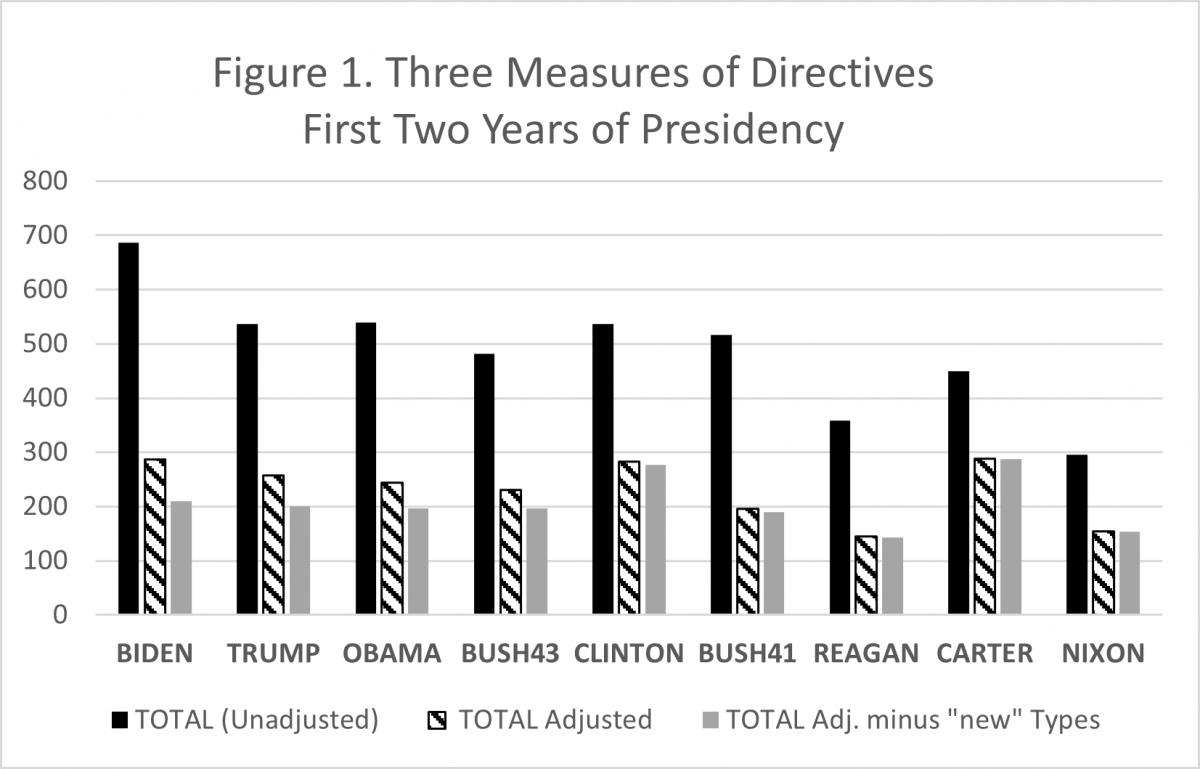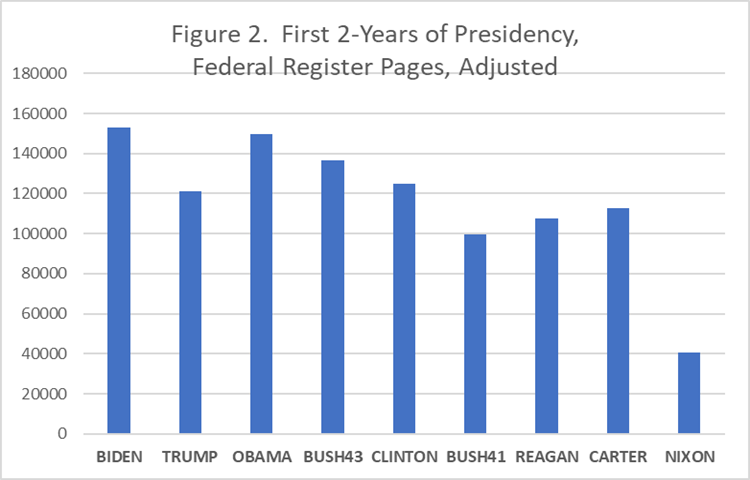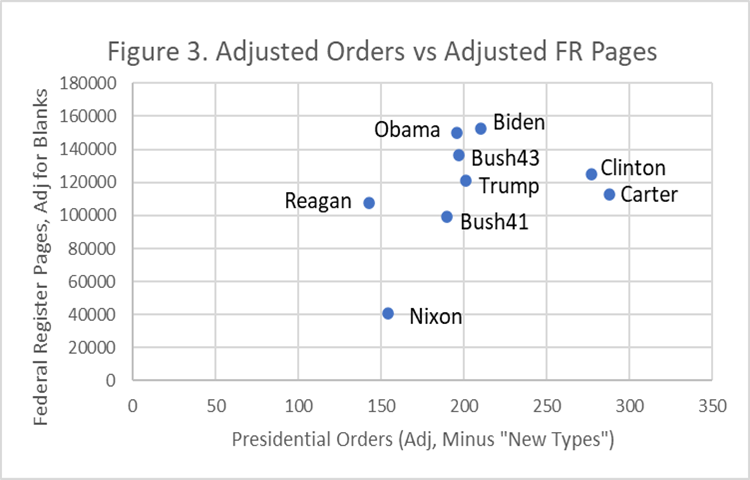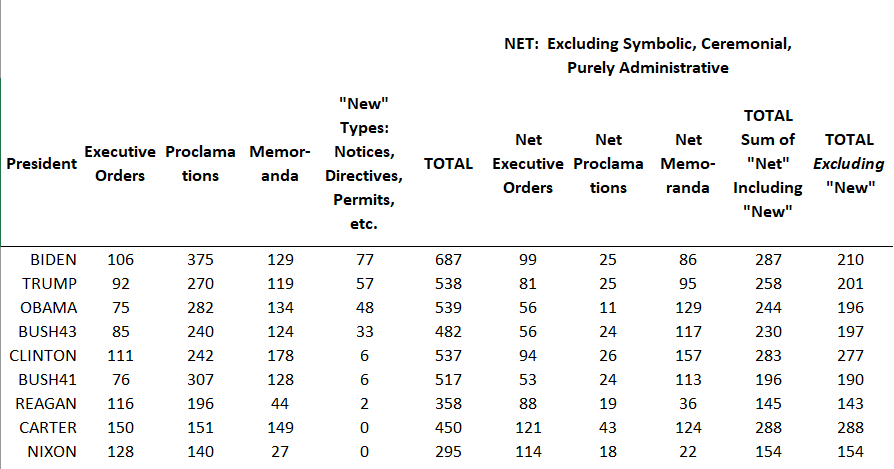Executive Action: President Biden vs His Predecessors
Biden has set records for issuing orders, but the differences with other recent presidents are not dramatic. This conclusion is based on content-adjusted counts of documents in the APP archives supplemented with some external data. The basic story with presidential orders is summarized in a nearby graph (figure 1) and discussed in more detail below.
In all cases, Presidential directives can be reversed when they are opposed by very large Congressional majorities. Such large majorities are very rare these days concerning issues with any degree of controversy. As a general proposition, then, one might expect presidents to use discretionary executive action aggressively whenever they have sufficient Congressional support to block reversal. That usually means a sufficient number of Senators to block a successful veto override. Those conditions have been quite common in the period examined in this essay.
As with any question like this, a full comparative analysis of Biden's action requires qualitative judgments. How aggressively did the President approach the boundaries of existing law in actions taken to overcome Congressional stalemate? It is not possible to thoroughly explore that issue here.
But, the bottom line is that Biden's use of discretion does not appear to be unprecedented in its scope and ambition.
The Graph: Contrasting Biden to Recent Presidents.
First, consider the bar graph below (Figure 1). The graph shows the use of presidential directives in the first two years in office, by first-term, elected presidents starting with Nixon in 1969.

The first bar, solid black, is the unadjusted total of seven categories of orders. It includes Executive Orders, Proclamations, Memoranda, Notices, Sequestration Orders, Directives, and Presidential Permits. Biden clearly has the most. However, that number is not a good representation of presidential efforts to move substantive policy in the executive branch. It includes routine administrative orders and hundreds of symbolic proclamations honoring all kinds of causes and events.
The second bar, with diagonal stripes, reflects a total that attempts to remove obviously non-directive orders. The most common of these are symbolic proclamations. There are many others, especially memorandums, that are purely administrative. That is, they do not include any indication of expected policy direction or content. A common example is a "Delegation of Authority" from the President to an agency official.
With respect to these striped bars, Biden is near the top of the distribution, but he is not alone. All the presidents except for Reagan and Nixon are within a standard deviation of the mean of the striped bars.
The third bar, solid gray, excludes Notices and other kinds of orders that have been infrequently used--or, perhaps, published--Sequestration, Directives, and Permit. Notices are required under the 1976 National Emergencies Act, which became effective in late 1978. Under this act, presidents can proclaim emergencies, subject to congressional review, and then must renew the emergency annually by notifying Congress--i.e., they issue a Notice. As the number of ongoing emergencies has increased over time, the number of Notices has also increased. Sequestration Orders have been required by law since 2013. There also have been Presidential Policy Directives, National Security Presidential Directives, and Homeland Security Presidential Directives--only some of which have been published. Finally, only President Trump issued "Presidential Permits" intending to facilitate the construction of pipelines and international bridges.
Excluding this third, more narrowly defined, set of measures, Biden's use of discretion is almost indistinguishable from four of his close predecessors (Trump, Obama, Bush43, and Bush41).
What is Missed by Counting Individual Orders?
In Figure 1, every document is counted equally, without regard to its length, complexity, and potential applicability across the executive branch. Documents are counted because they were published and because they were assigned a particular title.
1. Some written orders contain multiple directives. A prior APP Analysis pointed out that one Biden Executive Order (13990) directs around 40 distinct actions. So, a simple tally of documents may be a poor estimate of the number of directives. As far as we know, nobody has yet extensively researched how often there are multiple directives in a single published order.
2. We know with certainty that some important Presidential directives were not published under any of the conventional titles (Executive Order, Proclamation, Memorandum).
Under President Trump:
· The US withdrawal from the Paris Agreement (aka Climate Accord) was announced in a speech. There is no other published directive.
· The withholding of funds from the World Health Organization (WHO) was announced in a News Conference. The President said he was "instructing my administration. . . " but there was no published directive.
· The "President's decision," to withdraw from the United Nations Human Rights Council, was announced by the White House, but there was no published directive.
· A Statement indicated that the Department of Homeland Security would begin "an orderly transition and wind-down of DACA," but, again, without a published directive.
Similarly, President Biden:
· Re-entered the Paris Agreement by issuing a Statement.
· Released a statement saying he had "requested" the Secretary of Education to continue the pause in student loan payments, but without a published directive to the Secretary.
· Reversed Trump's withdrawal from the WHO in a letter.
· Announced his "renewed engagement on the Human Rights Council" in the course of remarks.
3. Some important agency actions sought, promoted, and praised by the White House were not the direct object of conventional Presidential orders. Examples include Obama's DACA policy and Biden's policies on student debt.
4. There are important levers for Presidential influence on Agency behavior that are not closely scrutinized or examined. Examples of this are the various forms of guidance issued by the Office of Management and Budget (OMB): Circulars, Bulletins, and Memoranda.
5. Labeling practices have not been consistent over time. In the early part of the study period, many symbolic orders were called "Executive Orders." More recently, they have almost always been "Proclamations.
Very generic statements of policy objectives in Presidential orders may bear fruit in numerous subsequent regulatory actions. So, a single order may have an impressive ultimate scope. For example, Trump's March 2017 Executive Order 13783 was subsequently cited in 72 proposed rules at regulations.gov--with at least 12 citations during the Biden Administration. This matter of future impact is a topic that bears more examination.
Whole of Government?
The Biden Administration's actions with respect to student loan debt have been undertaken through regulations of the Department of Education, previously published in the Federal Register. This example illustrates the reality that many regulatory activities of executive agencies are stimulated and encouraged by the White House. They may, however, be difficult to trace back to any specific published Presidential directive. With respect to the Biden program for student loan debt relief, as noted above, there appears to be no prior presidential order.
One way to try to capture the entirety of executive branch action is to focus on the size of the Federal Register (FR)--measured in pages. A vast share of federal government regulation is published in the FR. The total number of pages in the FR has been used many times as a rough measure of the magnitudes of federal regulatory initiatives. The FR page count usefully reflects simultaneously the number of individual regulatory proposals and their overall length and complexity.
It is fairly straightforward to calculate the number of pages between two dates, for example, defining the first two years of a presidential first term. There are, of course, lags at the first of any term when a great deal of FR content is actually the product of the prior administration. The numbers reported here make no adjustment for that lag. There have also been changes in FR publication practices that have affected the number of pages that are blank or without relevant content. (These blank pages have ranged as high as 15% of the total page count.) An estimate of these gaps can be made from precise annual data published at the Competitive Enterprise Institute.
In Figure 2, we present, by president, the total number of FR pages (adjusted for publication practices) in the first two years in office. Again, Biden tops the chart, but not by much. While Biden is at the top and Nixon at the bottom, all the other presidents are within 1 standard deviation of the mean. However, there is a steady overall upward trend. If we looked at two-year totals of FR pages from pre-Nixon presidencies, we would find that Nixon's two-year count, which looks low in Figure 2, is the largest of any prior two-year period.[1]

Presidential Orders vs Federal Register Pages
What is the relationship between the number of published presidential directives and the number of FR pages? A strong positive correlation might be informative about the logic of the growth of the regulatory state. Figure 3 shows the scatter plot.

"Adjusted" Orders exclude, as described above, symbolic, administrative, and "new" orders. The FR page count is adjusted to account for the frequency of blank pages.
The increase through time in the number of FR pages is apparent, but the correlation between these two data series is not very strong (r = .36). That is, the increase in FR pages does not have a very close contemporaneous link to the number of Presidential directives.
Again, considering President Biden, he is far from the top in terms of total (adjusted) presidential orders, but at the top, if barely, in terms of FR pages.
National Emergencies.
In March 1990 for the first time under the "National Emergencies Act," George Bush ended a national emergency--in this case, with respect to Nicaragua. In subsequent years through this writing, 19 Emergencies have been terminated (and others have expired). Biden terminated three--Trump's (February 2019) "Southern Border" emergency; Trump's (June 2020) International Criminal Court emergency (by executive order, not a proclamation), and Obama's 2015 Burundi emergency. However, in the period since the National Emergencies Act, Presidents have declared 70 national emergencies. (Trump 12; Biden 8)
|
President |
Number of National Emergency Declarations |
New Emergency Declarations First two years |
Terminations of Emergency, First two years |
|
Nixon |
2 |
1 |
0 |
|
Carter |
2 |
0 |
0 |
|
Reagan |
4 |
0 |
0 |
|
Bush41 |
5 |
3 |
0 |
|
Clinton |
14 |
6 |
0 |
|
Bush43 |
13 |
4 |
0 |
|
Obama |
12 |
2 |
0 |
|
Trump |
12 |
3 |
0 |
|
Biden |
8 |
8 |
3 |
On 16 occasions presidents have "expanded the scope of" prior national emergency declarations (Clinton, 1; Bush43, 4; Obama, 6; Trump, 0; Biden 5). In all cases, the expansions of scope addressed basically foreign targets
It appears that since the passage of the National Emergencies Act, only President Trump has declared a domestic "National Emergency" (not to be confused with a "Public Health Emergency"). The first of these domestic orders was the "Southern Border" emergency, in Proclamation 9844. Trump twice vetoed Congressional Resolutions to terminate this emergency, thereby illustrating a fundamental political condition facilitating presidential use of such directives.
The emergency declaration meant that the military could assist the Department of Homeland Security at the border and funds could be expended in order to "undertake military construction project, not otherwise authorized by law" in support of the armed forces (10 US Code 2808). Biden ended this emergency on the day he took office.
Trump's COVID-19 National Emergency provisions allowed for suspensions of loan payments on student loans (and many other features). Trump and Biden both extended the emergency relief measures repeatedly. Biden extended the reach of the loan suspension program, before ending it altogether at the end of 2022. He also announced that the entire COVID-19 National Emergency would end as of May 11, 2023. However, in October 2022, replacing and expanding emergency powers, the Department of Education published a rule to expand and continue student debt relief tied to income levels.
Biden also built on the Trump COVID-19 National Emergency with an OSHA Emergency Temporary Standard (effective 6/21/2021) to require in healthcare settings multiple approaches to limiting the spread of COVID-19 (encouraging vaccination, personal protective equipment).
Litigation.
Instances of litigation are a possible indicator of which presidential orders are controversial. The attorneysgeneral.org website has extensive data on litigation involving specific administrations. Not all of the cases involve particular presidential orders, but many do. When they focus on regulatory actions, it is always the case that an administration could have taken different actions.
The data show that 67 cases were initiated against the Trump Administration in his first two years in office. The Biden Administration was the target in 57 cases initiated in his first two years. While Biden's case count is less than Trump's, it is more than any other president since Reagan in the first two years.
At the time Biden took office, litigation was pending before the Supreme Court concerning the legality of the border wall construction expenditures President Trump had authorized under his Southern Border Emergency Declaration. One of Biden's first acts was to issue a Proclamation terminating the Southern Border Emergency. In a ruling on August 3, 2021, the Court declared previous judgments to be vacated and sent the case back to the 9th Circuit to "consider what further proceedings are necessary and appropriate in light of the changed circumstances in this case." This disposition left unresolved important questions about the legitimacy of presidential use of emergency declarations to bypass an uncooperative Congress.
Summary
Biden has faced exactly the institutional configuration that one would expect would encourage presidents to "push the boundaries" on the use of executive discretion: he has enough support in Congress to block most efforts to reverse his actions. However, this research has shown that Biden is, for the most part, not really very different from his predecessors.
Further Details
Executive order "exclusions" include: Delegations of Authority; Order of Succession; Holiday observances; and the creation of advisory boards, councils, committees and task forces with predominantly private citizen membership (i.e., not interagency coordinating councils).
Counts of "notices" continuing emergencies do not include messages to Congress informing them of the Notice.
Data Underlying Figure 1.

[1] A simple linear trend of adjusted FR page numbers from 1936-2021 would suggest that Biden is actually below the long-run trend in both of his first two years in office.
